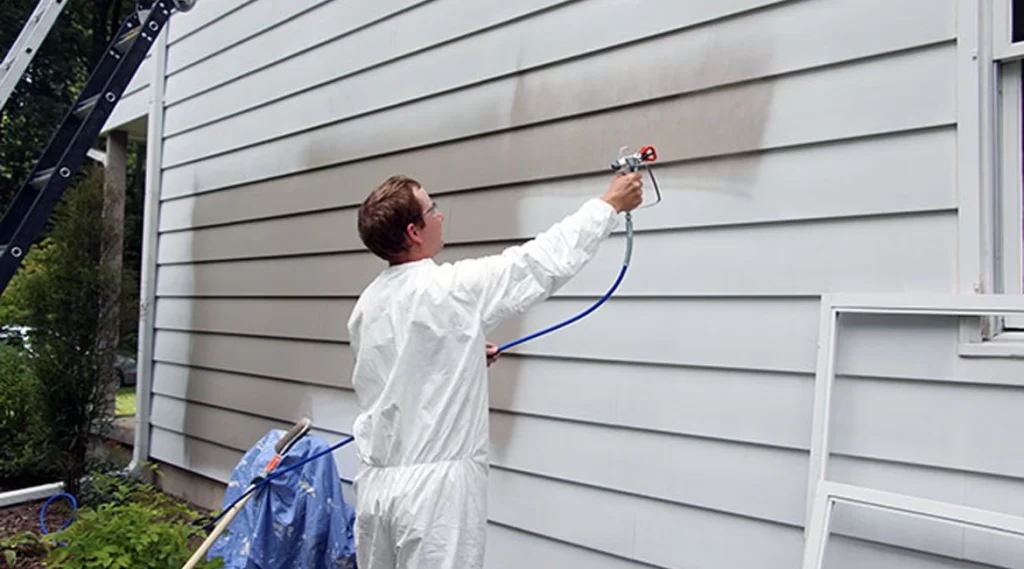Painting your house is one of the best ways to keep it fresh, vibrant, and welcoming while protecting it from the elements. But how often should you paint your house?
Why Regular Painting Is Important
Painting your house regularly is important for several reasons. It not only improves the appearance of your home but also provides a protective barrier against weather damage, insect infestation, and other forms of wear and tear.
Regular painting can also increase your property’s value, curb appeal and extend its lifespan.
Factors That Determine the Frequency of Painting
Several factors influence how often you should paint the exterior of your house.
Factors to consider include the type of paint being used, the climate of the local area, and the building materials that have been used in the construction of your home.
Let’s have a more in-depth look at each of these factors
Choosing the Right Paint Type
The type of paint you use plays a significant role in determining how often you need to repaint your house. High-quality paints typically last longer and provide better protection against the elements. The two main types of paint are:
- Water-based (latex) paint: This type of paint is easy to clean and has a lower odor. It typically lasts between 5 to 7 years.
- Oil-based (alkyd) paint: This paint is more durable but has a stronger odor and takes longer to dry. It can last between 7 to 10 years.
Considering The Climate
The climate of your location greatly affects the longevity of your paint job. Harsher weather conditions, such as extreme heat, cold, or humidity, can cause the paint to deteriorate faster. Here are some climate-related factors to consider:
- Sunlight: Intense sunlight can cause paint to fade and crack.
- Rain and humidity: Moisture can lead to mold, mildew, and paint peeling.
- Temperature fluctuations: Frequent temperature changes can cause paint to expand and contract, leading to cracks and peeling.
Take The Building Materials Into Consideration
The materials used in the construction of your home can also impact the frequency of painting. Different materials have varying levels of durability and require different types of paint:
- Wood siding: Requires painting every 3-7 years, depending on the quality of paint and climate.
- Stucco: Typically lasts 5-10 years before needing a new coat of paint.
- Brick: Can last up to 15-20 years with a high-quality paint job.
- Vinyl siding: Rarely requires painting but may need a new coat after 20-30 years for aesthetic purposes.
Signs It’s Time to Repaint Your House
How often you have to repaint a house can be answered by keeping an eye out for the following signs:
- Peeling or cracking paint
- Fading or discoloration
- Mold or mildew growth
- Damaged or rotting wood
- Exposed primer or bare spots
Selecting the Right Paint for Your Home
When it’s time to repaint your house, make sure to choose a high-quality paint that is appropriate for your home’s material and the local climate. Look for paints with UV protection and a warranty to ensure lasting results.
DIY vs. Professional Painting: What to Consider
One of the issues to think about is whether you would like to hire a professional to paint your home or attempt it yourself.
A professional will have the knowledge, expertise, and equipment to produce a high-quality finish in a relatively short amount of time.
Painting your home yourself can be very satisfying, but you will need to learn the necessary skills and invest money into buying the equipment needed for the job.
Preparing Your Home for Painting
Being prepared is key to a successful paint job. To prepare your home for painting, follow these steps:
- Clean the exterior: Remove dirt, mildew, and debris using a pressure washer or a brush and soap.
- Repair any damage: Fix cracks, holes, or damaged siding before painting.
- Scrape off loose paint: Remove any peeling or flaking paint to ensure a smooth surface.
- Sand rough surfaces: Smooth out any rough spots for better paint adhesion.
- Prime bare spots: Apply a primer to exposed areas to improve paint adhesion and coverage.
Choosing the Right Color for Your Home
Selecting the perfect color for your home can be a challenging task. Consider these factors when making your decision:
- Architectural style: Choose a color that complements your home’s architectural style and features.
- Neighborhood: Consider the color schemes of neighboring homes to create a cohesive look.
- Landscaping: Take into account the colors of your plants, trees, and other landscaping elements.
- Personal preferences: Ultimately, choose a color that reflects your personality and preferences.
Painting Techniques for a Professional Finish
To achieve a professional-looking paint job, follow these painting techniques:
- Use a brush for detail work: Brushes provide greater control and precision for cutting in and painting around the trim.
- Use a roller for larger surfaces: Rollers allow for faster, more even coverage on large, flat surfaces.
- Apply two coats of paint: Two coats of paint ensure better coverage, durability, and color consistency.
- Paint in the right conditions: Avoid painting in direct sunlight, high winds, or extreme temperatures for the best results.
Proper Maintenance to Extend the Life of Your Paint Job
Regular maintenance can help extend the life of your house paint and keep your home looking fresh:
- Clean your home’s exterior: Regularly remove dirt, mildew, and debris to prevent paint damage.
- Inspect for damage: Check for signs of damage, such as peeling paint or wood rot, and address issues promptly.
- Keep landscaping in check: Trim trees and bushes near your home to prevent moisture buildup and paint damage.
- Touch up as needed: Address small issues, such as chips or peeling paint, to keep your home looking its best.
Eco-Friendly Painting: Tips to Consider
When painting your house, it’s essential to consider the environmental impact. Choose eco-friendly paints with low VOC (volatile organic compound) levels to reduce air pollution and potential health risks. Additionally, dispose of paint and painting materials responsibly by following local waste disposal guidelines.
Budgeting for a House Painting Project
The cost of painting your house can vary depending on the size of your home, the type of paint used, and whether you hire a professional or do it yourself. To budget for your painting project:
- Calculate the cost of paint and supplies: Determine the amount of paint needed and factor in the cost of brushes, rollers, and other materials.
- Get multiple quotes: If hiring a professional, obtain multiple quotes to find the best price and service.
- Plan for unexpected expenses: Set aside additional funds for potential repairs or other unforeseen costs.
Final Thoughts
The frequency at which you should paint your house depends on factors such as paint type, climate, and building materials.
Regularly inspect your home for signs that it’s time to repaint, and take the necessary steps to ensure a professional finish. With proper care and maintenance, a high-quality paint job can keep your home looking beautiful and well-protected for years to come.
Reach out to our team at Infinity Painting today for professional, friendly advice on painting your home, and all your painting needs!

